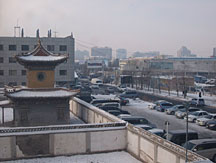- Number 365 |
- June 18, 2012
Berkeley Lab scientists tackle air pollution in Mongolia

Ulaan-Bataar is among the most
polluted cities.
Windswept Ulaan Bataar, the capital of Mongolia, is one of the most polluted cities in the world. Much of the problem can be traced to the coal-burning stoves used for heating and cooking in the city’s common form of housing, the round, tent-like structures called gers.
Ashok Gadgil, director of the Environmental Energy Technologies Division (EETD) at DOE’s Lawrence Berkeley National Laboratory, is well known for his high-efficiency cookstoves used in the refugee camps of Darfur and in Ethiopia and Haiti. Now Gadgil and his colleagues are working with the Millennium Challenge Corporation (MCC), a U.S. foreign aid agency, to improve air quality in Mongolia’s capital city by lowering emissions from outdated stoves and boilers. A small team of EETD scientists led by Maithili Iyer and Larry Dale, working with MCC through the DOE, has traveled to Mongolia to lend technical guidance to implement the new stove program and evaluate it.
“In the long run, Mongolia would benefit from moving away from coal-burning stoves altogether,” says Iyer, “but in the short term, promoting cleaner stoves is the most cost-effective way to maximize reductions in particulate matter.”
“A lot of Mongolians are migrating to the cities for jobs and better schools for their children,” says Dale. “They continue to live in their tents and heat them, when it’s minus 40 degrees outside, with traditional stoves.” Dale estimates more than half of Ulaan Bataar’s 1.6 million inhabitants are living in ger districts on the outskirts of the capital, with the result that the city’s concentrations of particulate matter are among the world’s highest.
The MCC began looking for cleaner-burning stoves in 2010. The Berkeley Lab experts helped identify two good candidates, with one, the Turkish-made Silver Mini, showing a stellar five-fold reduction in particulate emission in laboratory tests. Silver Minis burn the coal from top to bottom, while the traditional stoves burn from bottom to top. Distribution of the Turkish stoves began in the spring of 2011, and by the end of the year some 50,000 had been sold, subsidized by the MCC stove program and a government subsidy.
“In addition to burning cleaner, the new stoves are also more efficient,” says Jim Lutz, another researcher on the team, “so families buy less coal.”
To monitor and evaluate the new stoves, a separate team led by Dale went to Ulaan Bataar to collect data from 20 households. The researchers brought back the data plus a Silver Mini to test in a lab, set up to replicate local conditions.
“We’re trying to test it according to how people are actually using the stove, and capture the emissions at different stages,” says team member Agnes Lobscheid. They found potential challenges associated with the way users light and refuel the new stove.
“There’s an important role Berkeley Lab can play in understanding – and making sure that consumers understand – the relationship between proper stove operation and maintenance and air pollution reduction, so that emissions gains will be realized and sustained,” Dale says.
In addition to stoves, the project is researching low-pressure boilers for heating homes and gers, explains Iyer, to find out if any of them are cleaner than the traditional boilers. If they are, the plan is to increase their market penetration. Large boilers used in the city’s power plants are also under review.
“While there’s much work to be done, the Lab is helping MCC take real steps towards improving air quality in Mongolia,” says Iyer. “It’s only a matter of finding the right technology and scaling it up in a rational way.”[Julie Chao, 510.486.6491,
jhchao@lbl.gov]
